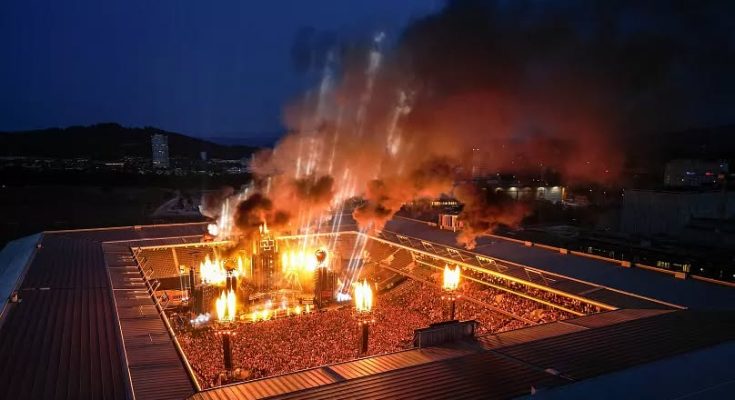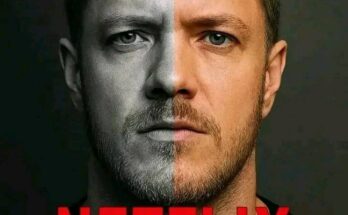James Hetfield vs. Till Lindemann: Battle of Legends — Who Truly Reigns as Metal’s Most Iconic Frontman?
In the vast and thunderous world of heavy metal, few figures command the level of awe and influence that James Hetfield of Metallica and Till Lindemann of Rammstein do. Both men stand as towering symbols of power, charisma, and artistic mastery—embodying two distinct yet equally formidable visions of what it means to lead a band that defines generations. The debate over who reigns supreme as metal’s most iconic frontman isn’t just a matter of taste—it’s a clash of eras, styles, philosophies, and cultural legacies. Hetfield and Lindemann are more than performers; they are forces of nature, each reshaping the boundaries of what a frontman can be.
James Hetfield, the co-founder, rhythm guitarist, and lead vocalist of Metallica, helped forge the sound of modern metal in the fires of the early 1980s. With his down-picking precision, growling vocals, and primal energy, he became the voice of rebellion and defiance for millions. From the raw aggression of Kill ’Em All to the monumental anthems of Master of Puppets and the world-conquering Black Album, Hetfield’s influence transcends generations. His presence on stage—commanding, stripped of gimmicks, and authentically raw—epitomizes the spirit of American heavy metal: honest, relentless, and electrifying.
Till Lindemann, on the other hand, emerged from the industrial heart of Germany with a completely different approach to metal stardom. As Rammstein’s frontman, he fused theater, provocation, and poetry into one unholy spectacle. Clad in military-style uniforms, wielding flamethrowers, and reciting lyrics like apocalyptic sermons, Lindemann turned every performance into a grand display of controlled chaos. His deep, rumbling baritone voice became synonymous with German industrial metal—cold, sensual, and unapologetically intense. Where Hetfield embodied the everyman hero, Lindemann became the enigmatic provocateur, blurring the line between art and danger.
To compare these two titans is to explore the dual nature of metal itself. Hetfield is the warrior of the people, channeling the frustrations and hopes of blue-collar America through a guitar riff and a clenched fist. Lindemann, meanwhile, is the dark poet of Europe’s postmodern psyche—a man whose performances mix brutality and beauty in equal measure. Each stands as a mirror of their culture. Hetfield grew from California’s underground thrash scene, where authenticity and energy ruled above all. Lindemann rose from the shadows of East Germany, where repression and conformity bred a hunger for expression through shock, art, and rebellion.
Hetfield’s legacy is one of consistency and endurance. For over four decades, he has kept Metallica at the summit of heavy music through countless evolutions. From the blazing speed of the early years to the polished grooves of the ’90s and the introspective tones of the 2000s, Hetfield adapted without ever losing the essence of who he is. His lyrics—raw, confessional, and often spiritual in their depth—reflect a man at war with himself and the world around him. Songs like “One,” “Fade to Black,” and “The Unforgiven” showcase his ability to channel vulnerability into power, a trait that few metal artists can achieve without losing their edge.
Till Lindemann, however, has always been about the spectacle—the grand illusion of control within chaos. On stage, he is both commander and actor, poet and executioner. His performances with Rammstein are not concerts in the traditional sense but cinematic experiences drenched in fire, smoke, and raw emotion. His lyrics, written mostly in German, explore taboo subjects—love, pain, death, dominance, and submission—with a literary finesse that makes him as much a dramatist as a musician. Lindemann’s work transcends language barriers; audiences across the world feel his energy without necessarily understanding his words. That’s the mark of a true performer—one who communicates through energy, not explanation.
Yet at the heart of this comparison lies a deeper question: what makes a frontman truly iconic? Is it technical ability, stage presence, emotional depth, or the capacity to transform an audience? Hetfield’s voice may lack the operatic flair of Lindemann’s, but it carries a raw sincerity that connects instantly. When he belts out “Master! Master!” or leads tens of thousands in chanting “Yeah!” during “Enter Sandman,” he creates an almost spiritual bond. His power lies in unity, in making his fans feel like part of something larger—a tribe forged in sweat and sound.
Lindemann, conversely, operates through domination and theater. His performances are rituals of control and surrender, with the audience both in awe and slightly terrified. There’s an erotic tension to his stage persona—half soldier, half priest—that keeps fans enthralled. He doesn’t seek unity; he seeks transformation. Each show is a confrontation with the darker corners of human nature, wrapped in fire and industrial rhythm. If Hetfield leads with heart, Lindemann leads with force—and both are equally mesmerizing in their own right.
Their cultural footprints tell different stories of influence. Metallica, under Hetfield’s guidance, became the world’s biggest metal band, breaking through to mainstream audiences without ever abandoning their roots. Their music defined an entire generation, from rebellious teens in the 1980s to festival-goers in the 2020s. Hetfield’s riffs have become part of rock’s DNA—instantly recognizable, endlessly imitated. His down-stroke technique alone inspired countless guitarists to pick up an instrument. Beyond music, he represents resilience: a man who faced addiction, fame, and personal demons yet continues to stand tall.
Lindemann’s legacy, while more controversial, is equally monumental. He turned Rammstein into a cultural phenomenon that transcended borders and languages. His visual artistry set new standards for live performances, influencing artists far beyond the metal scene. Even pop and electronic acts have drawn from his aesthetic—proof that Lindemann’s reach extends beyond genre. His solo work, often poetic and darkly humorous, showcases his multifaceted creativity. Where Hetfield embodies the purity of metal’s sound, Lindemann embodies its spirit of rebellion and performance art.
In the realm of influence, Hetfield arguably shaped the sound of metal itself, while Lindemann redefined its image. Metallica inspired generations of musicians, while Rammstein inspired generations of performers. Hetfield made the stage a place for raw truth; Lindemann turned it into a theater of dreams and nightmares. Both elevated metal into something transcendent.
The personal dimension of their artistry also offers fascinating contrasts. Hetfield’s public persona has evolved from the fiery young thrasher to the reflective elder statesman of metal. His humility and honesty about his struggles make him relatable—he is human, flawed, yet indestructible. Lindemann, by contrast, remains enigmatic, even mythical. He rarely reveals his inner self outside of his art, allowing mystery to become part of his power. His poetry, however, reveals glimpses of the man beneath—the romantic, the melancholic, the philosopher cloaked in armor.
It’s also worth noting how each frontman uses language as a weapon. Hetfield’s lyrics, grounded in English, speak directly to universal emotions—anger, guilt, redemption. Lindemann’s use of German, on the other hand, gives his songs a unique sonic weight and cultural resonance. The harsh consonants, the rhythmic cadence, the poetic phrasing—all add layers of intensity to Rammstein’s sound. Both artists, in their own linguistic ways, elevate words into tools of transcendence.
When Metallica performs live, Hetfield’s energy is organic—a communion between man and crowd. His charisma doesn’t come from theatrics but from authenticity. You believe him when he screams; you trust him when he smiles. His power lies in connection. Lindemann’s charisma, however, is sculpted like a sculpture of fire and shadow. He doesn’t seek trust—he commands attention. He crafts a world where the line between reality and performance blurs, and the audience willingly steps into the inferno with him.
If Hetfield is the heartbeat of metal, Lindemann is its theatrical soul. One moves through rhythm; the other through ritual. One finds transcendence through unity; the other through shock and awe. And that’s what makes their coexistence in metal’s pantheon so vital—they represent the genre’s two extremes, its heart and its shadow.
So, who truly reigns as metal’s most iconic frontman? The answer depends on how one defines “iconic.” If it means shaping the genre’s core and leading the most successful metal band of all time, James Hetfield stands unchallenged. His influence on sound, style, and spirit is immeasurable. But if being iconic means embodying the art form’s ultimate expression—bold, provocative, and transformative—then Till Lindemann holds that crown.
In truth, the debate isn’t about superiority but balance. Hetfield and Lindemann exist as dual guardians of metal’s empire: the creator and the performer, the craftsman and the poet. Each brought something essential to the genre—Hetfield, the thunder of raw emotion and precision; Lindemann, the blaze of spectacle and danger. Their legacies intertwine, proving that metal’s power lies not in uniformity but in diversity.
As the years roll on, both men continue to evolve, still commanding crowds that span continents and generations. Hetfield’s voice, though weathered, carries the same fire it did decades ago. Lindemann’s stagecraft grows ever more elaborate, his imagery ever more provocative. Neither has softened with age—they have only deepened, like iron forged in flame.
Ultimately, the battle between James Hetfield and Till Lindemann isn’t one that needs a victor. It’s a celebration of two sides of the same coin—the primal and the poetic, the American and the European, the guitar and the flame. Together, they define what it means to be truly iconic in metal: fearless, timeless, and utterly unforgettable.
In the thunderous halls of rock history, their names will forever echo—Hetfield, the architect of metal’s might, and Lindemann, the firebrand who turned performance into art. Two legends. Two legacies. One eternal question—and one undeniable truth: metal would not be the same without either of them.



